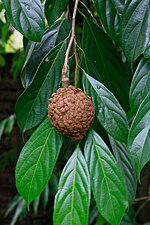Hydnocarpus wightianus
| Chaulmoogra | |
|---|---|
| Scientific classification | |
| Kingdom: | Plantae |
| Clade: | Tracheophytes |
| Clade: | Angiosperms |
| Clade: | Eudicots |
| Clade: | Rosids |
| Order: | Malpighiales |
| Family: | Achariaceae |
| Genus: | Hydnocarpus |
| Species: | H. wightianus
|
| Binomial name | |
| Hydnocarpus wightianus | |
Hydnocarpus wightianus or chaulmoogra is a tree in the
Common names
Common name: Jangli almond
- Hindi: कालमोगरा Calmogara, Chalmogra, Chaulmoogra,[5] Jangli badam
- Kannada: Chalmogra yenne mara, Mirolhakai, Surti, Suranti, Toratti, Garudaphala
- Malayalam: Kodi, Maravatty, Marotti, Nirvatta, Nirvetti
- Marathi: Kadu Kawath
- Sanskrit: Tuvaraka, Turveraka, Tuvrak, कुष्टवैरी Kushtavairi
- Tamil: Maravetti, Maravattai, Marotti
- Telugu: Niradi-vittulu
Habitat
In India: It grows in
, often planted on road sides in hilly areas.Other countries: The tree is found in South East Asia, chiefly in the Indo-Malayan region, and cultivated in Sri Lanka, Nigeria and Uganda.[6]
Morphology
This is a
Trees of the species that yield Chaulmoogra oil grow to a height of 12–15 m (39–49 ft) and in India trees bear
Chaulmoogra oil




The oil from the seeds of Hydnocarpus wightianus (Chaulmoogra) has been widely used in various forms of traditional Indian medicine and in
The chemical constituents of the oil were analyzed for their potential pharmacological activity by Frederick Belding Power, working for Wellcome Chemical Research Laboratories, in 1904.[7] Power and colleagues isolated hydnocarpic acid, which had the formula , from seeds of both the Hydnocarpus Wightiana and Hydnocarpus anthelmintica trees.
Physical characteristics and composition
The oil is semi-solid at room temperature with no odor.
The crude oil has a pale greenish-brown color, and can be easily purified into a white, watery oil containing three cyclopentene
Table: fatty acid composition of oil[13]
| Acid | H. kurzil | H. wightiana | H. odorata |
| Hydnocarpic acid | 23.0 | 22.9 | .. |
| Chaulmoogric acid | 19.6 | 35.0 | .. |
| Gloric acid | 25.1 | 12.8 | .. |
| Lower cyclic homologs | 0.3 | 4.6 | .. |
| Myristic acid (C14:0) | 0.6 | 0.8 | 0.4 |
| Palmitic acid (C16:0) | 8.4 | 5.6 | 11.8 |
| Stearic acid (C18:0) | 1.6 | 4.7 | .. |
| Palmitoleic acid (C16:1) | 6.0 | 0.5 | |
| Oleic acid (C18:1) | 5.4 | 3.6 | 21.8 |
| Linoleic acid (C18:2) | 1.6 | 1.8 | 29.3 |
| Linolenic acid (C18:3) | .. | .. | 31.2 |
Table of physical properties of oil[14]
| Property | Range |
| Refractive index, at 400C | 1.472-1.476 |
| Iodine value | 98–103 |
| Saponification value | 198–204 |
| Acid value | Max. 25.0% |
| Melting point | 20–25 °C |
Specific gravity (at 25 °C) |
0.950-.960 |
Extraction
Seeds are ovoid, irregular and angular, 1 to 1 1/4 inches long, 1 inch wide, skin smooth, grey, brittle; kernel oily and dark brown. A fatty oil is obtained by expression, known officially as gynocardia oil in Britain, as oleum chaulmoograe in the United States.[15]
Fruits are plucked by climbing the tree or using long sticks with a sickle tied to it. The fruits are peeled by knife and the seeds are washed in water and then dried in sun. Seeds are decorticated (dehusked) by mallet, hand hammer, or decorticator. They may also be crushed in an expeller and rotary. The kernels yield 43% oil. The extracted oil is stored in zinc barrels until exported.[6]
Leprosy

Chaulmoogra oil was commonly used in the early 20th century for the treatment of
An ethyl ester of the oil (the "Ball method") was developed by Alice Ball in 1916,[20][21] who died suddenly before publishing the technique. Her work was stolen by Arthur L. Dean who began producing large quantities of the treatment and named it after himself.[22]
It was then produced and marketed by
See also
References
- ^ Rumphia 4: 22. 1849. See IPNI [late Oct 1849]
- PMID 8089304.
- PMID 20749243.
- PMID 12894769.
- ^ a b "Hydnocarpus pentandrus – Jangli Almond". Flowersofindia.net. Retrieved 21 November 2013.
- ^ a b c SEA HandBook, 2009 by the Solvent Extractors' Association Of India
- ISSN 0368-1645.
- ^ PMID 12894769.
- PMID 8089304.
- PMID 4737104.
- ^ "Minor oil crops – Individual monographs (Allanblackia-Almond-Chaulmoogra-Cuphea spp.-Jatropa curgas)". Fao.org. Retrieved 21 November 2013.
- ^ Ranganathan, KR; Seshadri TR (1974). "Constitution of isohydnocarpin isolated from the seed hulls of Hydnocarpus wightiana". Indian Journal of Chemistry. 12: 993.
- PMID 4737104.
- ISBN 9788176252423. Retrieved 21 November 2013.
- ^ "A Modern Herbal | Chaulmoogra". Botanical.com. Retrieved 21 November 2013.
- )
- S2CID 81487422.
- PMID 4799554.
- ^ MacPherson, Hamish (10 January 2021). "Back in the Day: The Scots doctor who pioneered treatment for leprosy in India". The National. p. 11. Retrieved 11 January 2021.
- ^ a b Mendheim, Beverly (September 2007). "Lost and Found: Alice Augusta Ball, an Extraordinary Woman of Hawai'i Nei". Northwest Hawaii Times. Archived from the original on 3 March 2016. Retrieved 20 May 2013.
- ^ Organization, World Health (2020). "Elimination of leprosy as a public health problem". Report of an Informal Consultation Mexico City, Mexico, 10–12 February 2020. World Health Organization: 8–15 – via JSTOR.
- ^ Wermager, Paul; Carl Heltzel (February 2007). "Alice A. Augusta Ball" (PDF). ChemMatters. 25 (1): 16–19. Archived from the original (PDF) on 13 July 2014. Retrieved 18 June 2014.
- ^ Simpkin, Alice (December 1928). "The Treatment of Leprosy". British Journal of Nursing: 313–4. Archived from the original on 25 April 2012. Retrieved 22 October 2011.

